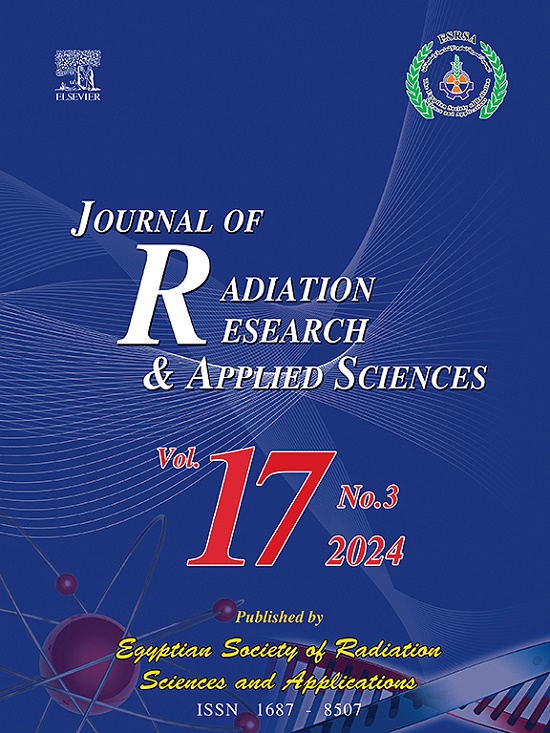热辐射下生物对流分层磁流体动力交叉混合纳米流体流动的熵建模
IF 1.7
4区 综合性期刊
Q2 MULTIDISCIPLINARY SCIENCES
Journal of Radiation Research and Applied Sciences
Pub Date : 2025-03-14
DOI:10.1016/j.jrras.2025.101415
引用次数: 0
摘要
微生物混合纳米流体(HNF)对于提高依赖生物过程的系统的效率和控制具有重要意义。这些可能包括生物技术、环境处理、生物医学工程和能源系统,在这些领域,增强的传热和纳米颗粒功能可以提供性能优势。当前研究的目的是仔细检查熵生成(EG)分层交叉杂交纳米材料流动的可拉伸圆柱体在回旋微生物的存在。混合纳米流体是通过将二氧化钛(TiO2)和银(Ag)的刚性纳米颗粒悬浮在水(H2O)基交叉流体中而开发的。考虑了达西-福希海默的特征和表面渗透率,建立了动量方程。在热能方程中考虑焦耳加热和热辐射影响。热、质量浓度和密度分层被考虑在表面的边缘。通过实现边界层假设,得到了流动控制模型。为了得到数值解,利用变换得到相应的ODE系统。利用数学软件来执行龙格-库塔-费伯格(RKF-45)的代码。图形调查进行了检查不同的物理变量对温度,熵率,速度,陀螺仪微生物,贝尚数和浓度分布的影响。此外,针对每个涉及的物理参数,对数值结果进行了表面阻力、质量、热量和运动密度传递率的分析。结果表明,较高的分层会降低生物对流杂化纳米流体场的热、溶质和密度分布。传热速率随哈特曼数和辐射参数的增大而增大。混合流体速度场和质量浓度场随曲率参数的增大而增大,热密度场和运动密度场则减小。此外,熵率和Bejan量通过Brinkman、Hartman和辐射变量加速。本文章由计算机程序翻译,如有差异,请以英文原文为准。
Entropy modeling in bioconvective stratified magnetohydrodynamic cross hybrid nanofluid flow with thermal radiation
Hybrid nanofluids(HNF) with microorganisms are significant for improving the efficiency and control of systems that rely on biological processes. These could include biotechnology, environmental treatment, biomedical engineering, and energy systems, where enhanced heat transfer and nanoparticle functionality can offer performance advantages. The aim of the current study is to scrutinize the entropy generation(EG) stratified cross hybrid nanomaterial flow by a stretchable cylinder in the presence of gyrotactic microorganisms. Hybrid nanofluid is developed by suspending rigid nanoparticles of titanium dioxide and silver into water based Cross fluid. Momentum equation is formulated accounting the features of Darcy-Forchheimer and permeability of the surface. Joule heating and thermal radiation impacts are considered in the thermal energy equation. Thermal, mass concentration and density stratifications are considered at the edge of the surface. The flow governing model is obtained by implementing boundary layer assumptions. To obtain the numerical solution, transformations are utilized to yield the corresponding system of ODE's. Mathematica software is availed to execute the code for the Runge-Kutta Fehlberg (RKF-45). Graphical investigation is carried out to examine the impact of diverse physical variables on the temperature, entropy rate, velocity, gyrotactic microorganism, Bejan number, and concentration profiles. In addition, against each involved physical parameter, the numerical results have been analyzed for surface drag force, mass, heat, and motile density transfer rates. The results show that higher stratification decays the thermal, solutal, and density profiles of the bioconvective hybrid nanofluid field. Heat transfer rate boosts versus Hartmann number and radiation parameter. Hybrid fluid velocity and mass concentration fields increase with rising curvature parameters, while thermal and motile density fields decrease. Furthermore, entropy rate and Bejan quantities accelerates through Brinkman, Hartman and radiation variables.
求助全文
通过发布文献求助,成功后即可免费获取论文全文。
去求助
来源期刊

Journal of Radiation Research and Applied Sciences
MULTIDISCIPLINARY SCIENCES-
自引率
5.90%
发文量
130
审稿时长
16 weeks
期刊介绍:
Journal of Radiation Research and Applied Sciences provides a high quality medium for the publication of substantial, original and scientific and technological papers on the development and applications of nuclear, radiation and isotopes in biology, medicine, drugs, biochemistry, microbiology, agriculture, entomology, food technology, chemistry, physics, solid states, engineering, environmental and applied sciences.
 求助内容:
求助内容: 应助结果提醒方式:
应助结果提醒方式:


